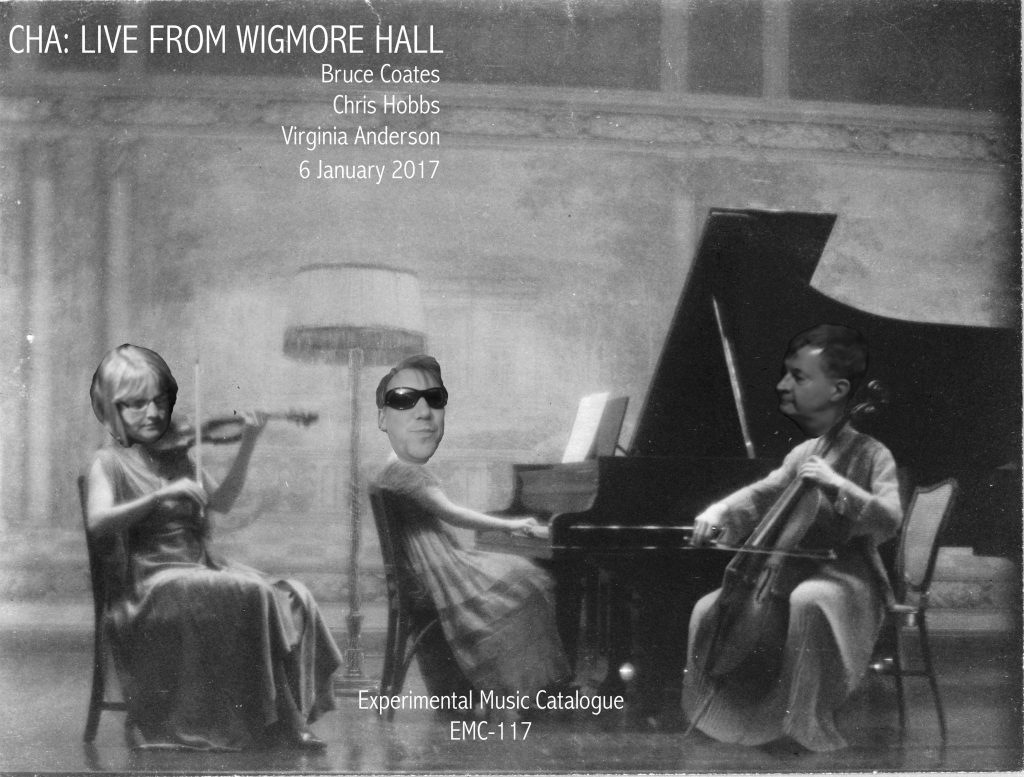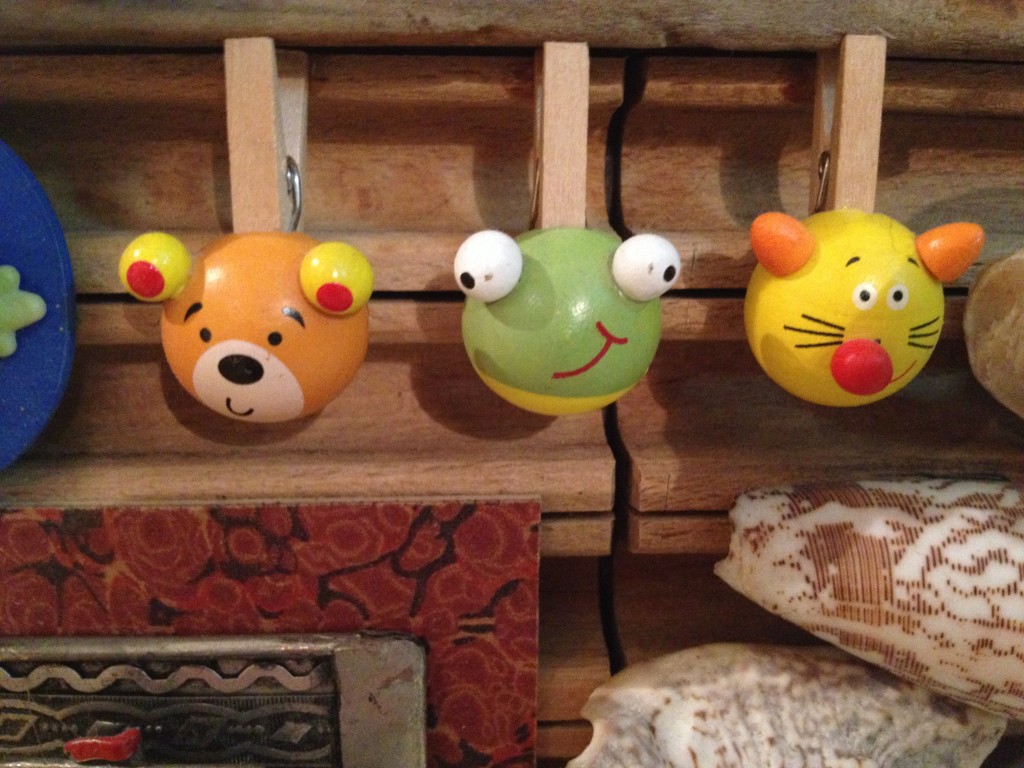
One of the most gratifying features of being on the Experimental Music Catalogue staff, and of researching British and West Coast American free improvisatory, experimental, minimal, and postminimal music, is that it is often so fun, due to an aesthetic criteria that I have described elsewhere as “humour as a noble emotion.” Instead of thinking that all good music must be weighty, scientific, made for the ages, a lot of these composers and performers, well, like to have a good laugh and use their full talents and experience to write top-quality music that is funny.
And the newest release on EMC Bandcamp from CHA (an acronym standing for Bruce COATES, Chris HOBBS, and me, Virginia ANDERSON)—CHA: Live from Wigmore Hall—began as a bit of banter. A couple of years ago, Chris Hobbs and I were driving along small country roads around Shropshire and Herefordshire, when we spotted a village sign reading “Wigmore”. Chris said, “I wonder if they have a village hall. We could play there and bill it as ‘Live from Wigmore Hall’!” This was quite a giggle: for anyone concerned with music in Britain, London’s Wigmore Hall is perhaps the premiere venue for chamber music in Britain . Built at the turn of the last century, it features stunning acoustics and hosts a weekly concert broadcast live by the BBC. Recordings issued as “Wigmore Hall Live” include works by Mozart, Beethoven, Tippett, Schubert, Britten, Brahms. To think that CHA would perform at such a bastion of classical masterworks was ludicrous. So we kept the idea in mind….
What happened—the recording, the album art, the release—has much to do with the culture of free improvisation and its “personality” and the way that CHA arose and works as a trio.
Music is Painful: The personality of free improvisation
The culture of free improvisation (meaning non-notated, usually non-tonal spontaneous performance by one or more musicians) has always seemed to me to resemble a family reunion. People assemble and interact. They may know each other well and for a long time; it may be their first meeting. Each participant brings in his or her own personality and skills to the meeting. Some players may interact with each other at their first meeting as if they had known each other their whole lives. Other players need to work with each other, to sound each other out, before they find their mix. Some players are like the favourite uncle, full of witty banter and jolly games. Some players—the free spirits—may make musical contributions that are spiritual, philosophical, or arcane (the pioneering group AMM, whose name is an acronym that is secret, has always cultivated an aura of mystery). Some players resemble an unpleasant second cousin, loudly and continuously braying out their prejudices, so that no one else can make conversation (such as the player who brought his homemade fretless bass to improvisations to make ceaseless unmusical booms). Then there are the serious souls, depicting the angst of the world both physically through their contorted bodies, and sonically. For them, improvisation is a serious business, and music is painful.
However, deep personal expression of angst is only one emotional affect that can be delivered through musical improvisation. The late Lol Coxhill was a particularly versatile performer of all sorts of free improvisation, jazz, indie popular music, and musical theatre, much of it full of delight rather than pain, and some of it laugh-out-loud funny. The Art Ensemble of Chicago, billing their concerts as “Great Black Music—Ancient to the Future” presented a panoply of styles and moods that changed from concert to concert. As one of the most “experimental” of Afrocentric bands, their use of toys, and Lester Bowie’s “scientific” experiments are perhaps closest to the experimental music in Britain that we enjoy here at the EMC. Bowie wore a white lab coat on Art Ensemble performances—a clear symbol of his role as “experimenter”. And Bowie’s exploration and ennoblement of the mundane, even tacky, corners of popular music reminds me of that great founding experimentalist, Erik Satie. His absolutely delightful album Fast Last! (1974), one of his non-Art Ensemble projects, mixed the track “F Troop Rides Again”, a meditation on the theme of one of the silliest of 1960s American comedy series, with the Broadway standard “Hello Dolly” and “Lonely Woman”, a haunting piece by Ornette Coleman. This equality of the deeply silly, the old standard, and the complex classic is reminiscent of much British experimental music since the late 1960s, especially the music of John White (whose titles and pieces can be simultaneously deep and silly), and it may lie in the deep subconscious of CHA improvisation. That is, if CHA, a spontaneous ensemble, actually stopped to think of it.
CHA: The Road to Wigmore
What CHA did think about was how to set up the joke. I found that, yes, indeed, there was a village hall at Wigmore that could be hired. So we booked a couple hours at the hall for 6 January and, on a day of flooding and pouring rain, Chris, Bruce and I met at the Village Hall. We brought our instruments, sound objects, toys and other materials. We also brought a picnic hamper filled with meat and cheese sandwiches on rye and a large bottle of Belgian beer.

This Wigmore Hall is more versatile than London’s Wigmore Hall, as it hosts keep-fit classes, meetings, and other events of interest to the villagers.

The decor is also somewhat different to that of the London Wigmore Hall, which is noted for its interior design and acoustics.

Wigmore Village Hall was decorated when we visited on 6 January with the last of the Christmas decorations. The hall’s acoustics are not bad, though unlike London, the Village Hall has no piano.
The Wigmore Hall recording
Both Chris and Bruce brought portable digital recording devices, recording in WAV format, so that there was a back-up. In the end, we used Bruce’s recording, because Bruce had better microphones. We set up the instruments, which included, for Chris, an Organetta (small reed organ), percussion, laptop with GarageBand loops, some toy noisemakers, and a radio. Bruce brought his saxophones (including a lurid plastic alto) and other sound sources, including dog toys, a metal thali, and comedy rubber animals. I brought three clarinets and stuck mainly to playing them, with only the occasional duck call.
The actual improvisation, which can be heard on the EMC Bandcamp page, is hard to describe in words. Basically, the nature of the instrumentation and the personalities of the trio gives the music a lighter, airier quality that a lot of free improv. There is more space, more short silences that many groups. And it is perhaps less aggressive than the so-called “sync or swarm” improvisation that is more commonly written about. There is a tendency toward a higher tessitura, as Bruce tends to favour his soprano and sopranino saxes, which I often match with my Eb sopranino clarinet. Chris tended to move around the room, to the dais, with its Christmas tree and his Organetta and radio; to the middle of the room, with the laptop and gong; and then carrying small percussion and his pennywhistle toward the entrance at the back of the hall. In the third set, “Consumption”, the combination of the little sax, little clarinet, and Chris’s pennywhistle set up a magnificent subharmonic drone that supported the high sounds, which, like so many subharmonics, was not picked up by the recording. Sometimes the sound world is jagged, but concords, even modality can show up. And of course, there are the toys: rubber chickens and sheep; a strange, squeaking dog toy in the form of a jack.

We decided that as much of the actual sounds that the microphones did pick up of the Wigmore Village Hall performance should be included, which is why, at the end of the first set, “Interruption”, a man’s voice can be heard. This “person from Porlock” (as Samuel Taylor Coleridge’s unwelcome visitor came to be known) wished to inform us that he and a couple other people would be using the smaller room of the hall to have a conversation. I pointed to the microphones, said, “We’re recording.” He apologized and exited. The second set, “Resumption”, and third set proceeded without further disruption, as our contented conversation at the end of “Consumption” shows. “Consumption” refers to the contents of the CHA picnic basket.
Producing the album
Bruce invented the titles after the recording and cover art had been made; indeed, after the liner notes were already in a completed draft. Titles for free improvisation tracks are perhaps the most arbitrary of all titles in music. There is no structure in free improvisation that would suggest a generic name like “sonata”; the mood or emotional “affect”, should there be one, often emerges only in real time. Many improvisers choose poetic, often obscure titles, such as “Later During a Flaming Riviera Sunset”, and “Ailantus Glandulosa” on AMM’s AMMmusic (1966). CHA has no such mystical identity: we have been primarily identified by pictures of toys (the small animal heads made by Bruce’s father, the artist Andrew Coates, which graced the promotional material for our 2013 concert at the Engine House, Manchester) or tea cups and mugs (a play on the British slang term for tea, “cha”).

This time, I wanted something that tied in with the Wigmore Hall association, so Bruce designed the cover using a copyright-free image of a piano trio of women from sometime in the 1920s. We saw, we giggled, we waited for someone to counsel for something more momentous to go with our great work for the ages, and when that objection never arose, we released CHA: Live from Wigmore Hall.
CHA, CHA, CHA….
So ends this explanation of the first CHA album. It is always a mistake to explain a joke, but since this was an in-joke between our trio, I thought I would provide some background, not just to the recording, but where it sits as experimental practice among more traditionally-minded modern music. Music does not have to be painful, though of course it can be; music can be pretty—it can be fun. I can’t wait for the next CHA adventure.
